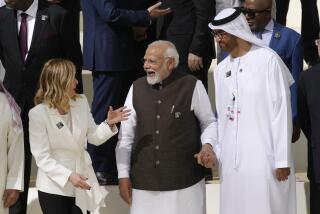India feels growing pressure to set target for emission cut
- Share via
Reporting from New Delhi — India found itself under growing pressure this week to set an emission reduction target after China and the United States announced their pledges in advance of a global summit on climate change that opens early next month.
The two Asian powerhouses, both of which have eschewed binding targets over concerns about undercutting national development, are seen in some Washington circles as the biggest impediment to an agreement.
China and India, as the world’s two most populous nations and with rapidly developing economies, have said they will work toward a common position on a climate deal. On Thursday, China announced a plan to pollute at a lesser rate compared with 2005 -- reducing emissions by 40% to 45% per unit of gross domestic product by 2020, and the U.S. pledged a 17% cut by 2020 in overall emission levels compared with those of 2005. But so far India has held back.
“It certainly puts pressure on India; we can’t live in a world of our own,” said Salman Haidar, an analyst and former Indian foreign secretary. “There may well be some internal churning over this.”
More than 190 nations are meeting in Copenhagen from Dec. 7 to 18, although entrenched bargaining positions, weak leadership and the global downturn make it unlikely that a final deal will be struck then.
India and China have argued that developed countries emit far more carbon dioxide and other harmful chemicals on a per-person basis than they do. They also say richer nations should shoulder most of the burden by transferring technology and compensating developing nations for cuts.
China’s pledge is not binding, and this week’s announcement only codifies plans already in place, said Kushal Singh Yadav, climate change project head at the Center for Science and Environment in New Delhi. And India has a better record on combating emissions so far, he said.
“But I admit by going ahead and announcing this, the perception is China’s doing a lot more,” Yadav said. “Most people won’t look into the details.”
Internally, India must weigh several factors in mapping out its next move, analysts and former diplomats said. Domestically, the government must consider how much economic pain and political opposition it can withstand in making any concessions.
Although almost every country is going through similar calculations ahead of the Copenhagen talks, India as a democracy -- and one that has suffered past voter revolts when its politicians were perceived as bowing to foreigners -- arguably faces more pressure than does China, with its more authoritarian system.
But India also has many international links -- as does China -- that have only grown stronger since economic reforms in 1992, and it can’t afford to look too parochial or defiant when it comes to an agreement.
“China has given us a wake-up call,” Indian Environment Minister Jairam Ramesh was quoted as saying by the Hindustan Times on Friday. “We have to think hard about our climate strategy now and look for flexibility.”
Analysts said they did not think this apparent break would increase tension between China and India, which have traded accusations in recent weeks over border boundaries, visa policy and the Dalai Lama. Their common line in climate talks lasts only as long as it serves both of their national interests, analysts said.
“The question is what the impact of any move will be on India’s economy,” Haider said. “I think that may weigh much more than that China and the U.S. seem to be moving in the same direction.”
Anshul Rana of The Times’ New Delhi Bureau contributed to this report.
More to Read
Sign up for Essential California
The most important California stories and recommendations in your inbox every morning.
You may occasionally receive promotional content from the Los Angeles Times.










